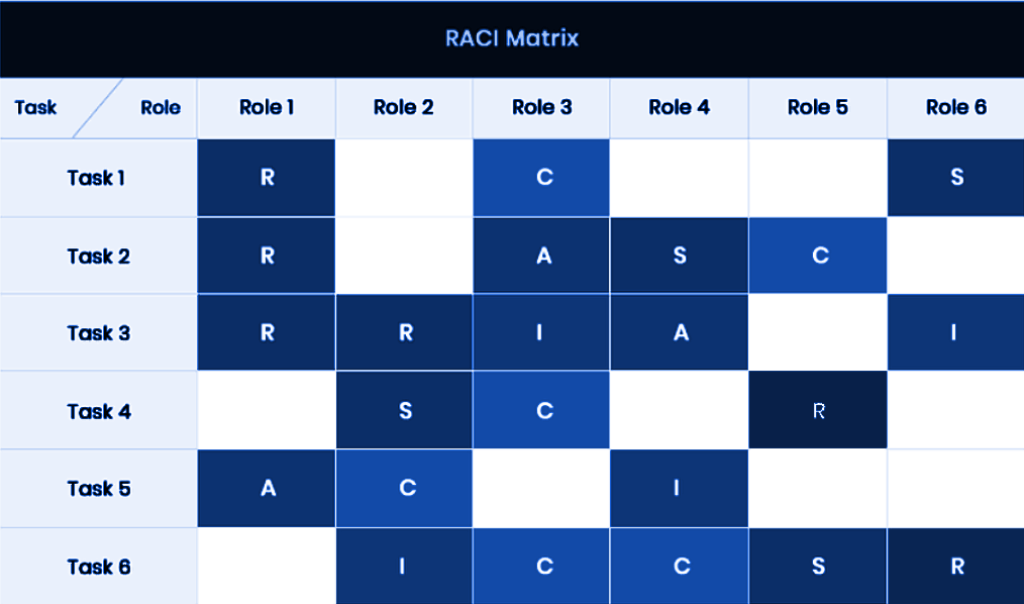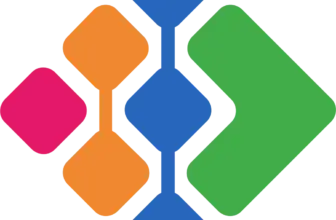
Introduction
DACI vs RACI, which one should you use? If you manage projects, you’ve likely come across these frameworks. Both help define roles and responsibilities, but they serve different purposes.
RACI ensures clarity in task ownership, while DACI focuses on decision-making. Picking the right one can improve efficiency, reduce confusion, and speed up project execution. In this guide, you’ll learn how each framework works, its key differences, and when to use them for the best results.
👉 Looking for a project management tool that supports both frameworks? Check out our comparison of the best project management software to see which platform fits your team’s needs.
What Is the RACI Model?
The RACI model is a widely used framework for defining who is responsible for what in a project. It ensures that every task has clear ownership, preventing bottlenecks and miscommunication.
RACI Roles and Responsibilities
RACI stands for:
- Responsible – The person (or people) who completes the task.
- Accountable – The ultimate decision-maker who ensures the task is done correctly.
- Consulted – Experts or stakeholders who provide input before execution.
- Informed – Those who need updates on progress but aren’t actively involved.
When Should You Use RACI?
The RACI framework works best when:
✔ Your team needs structured workflows with defined roles.
✔ You’re managing large projects with multiple contributors.
✔ Decision-making is hierarchical, and accountability must be clear.
💡 Tools like ClickUp make it easy to implement RACI matrices by allowing teams to define roles, assign responsibilities, and track progress all in one place.
However, RACI isn’t perfect. It can create overlap in responsibilities or slow down decision-making if too many people are “Consulted” in the process.
What Is the DACI Model?
The DACI model is a decision-making framework that ensures projects move forward efficiently. It focuses on who drives decisions rather than just assigning responsibility for tasks.
DACI Roles and Responsibilities
DACI stands for:
- Driver – The person who leads the decision-making process and coordinates actions.
- Approver – The final decision-maker who gives the go-ahead.
- Contributor – Subject matter experts who provide insights and recommendations.
- Informed – People who need to stay in the loop on decisions.
When Should You Use DACI?
The DACI framework is ideal when:
✔ Decision-making is centralized and critical to project success.
✔ You need clear approval processes to avoid delays.
✔ Your team is agile and works on iterative improvements.
📌 monday.com offers powerful decision-making tools that align with DACI principles, helping teams streamline approvals and keep stakeholders informed.
That said, DACI can be rigid if applied too strictly. If too many people are involved in decision-making, it may cause delays instead of solving them.

Key Differences Between DACI and RACI
While both DACI and RACI provide clear role definitions, they differ in their focus and application. DACI emphasizes decision-making, making it ideal for projects where swift, clear decisions are crucial. RACI, on the other hand, focuses on responsibility and accountability, making it better suited for projects with well-defined tasks and larger teams.
Both frameworks define roles, but their focus areas set them apart. Here’s a side-by-side comparison to help you decide which one aligns with your project needs:
| Aspect | RACI | DACI |
| Purpose | Task ownership & execution | Decision-making process |
| Key Focus | Who does what? | Who makes decisions? |
| Roles Defined | Responsible, Accountable, Consulted, Informed | Driver, Approver, Contributor, Informed |
| Best For | Large teams with task dependencies | Agile teams needing fast decisions |
| Common Pitfall | Can create confusion over responsibility levels | Can slow down execution if too rigid |
Breaking It Down Further
- RACI focuses on task execution, ensuring every responsibility is assigned clearly.
- DACI focuses on decision-making, ensuring that approvals happen efficiently.
- If your project struggles with ownership confusion, RACI helps clarify roles.
- If slow decision-making is a problem, DACI can streamline approvals.
Key Differences:
1. Decision-Making Focus:
- DACI: The DACI framework places a strong emphasis on decision-making. The Driver role is specifically responsible for driving the project forward and making critical decisions. The Approver has the final say on important matters, ensuring that decisions are aligned with the project’s goals and objectives. This clear delineation of decision-making roles makes DACI particularly effective in environments where quick, decisive actions are necessary.
- RACI: In contrast, the RACI framework focuses more on responsibility and accountability rather than on decision-making. While the Responsible role involves individuals who perform the tasks, the Accountable role is about ensuring that the tasks are completed correctly. Decision-making in RACI is more distributed, with Consulted individuals providing input and Informed stakeholders being updated on progress.
2. Role Overlap and Specificity:
- DACI: DACI roles can overlap more fluidly, allowing for flexibility in how team members contribute to the project. For example, a Contributor might also take on some responsibilities typically associated with the Driver, depending on the project’s needs. This flexibility can be beneficial in dynamic, fast-paced environments where roles need to adapt quickly to changing circumstances.
- RACI: RACI roles are more rigidly defined, with each role having a distinct and specific set of responsibilities. This clear separation of roles helps avoid confusion and ensures that everyone knows their exact duties. However, it can also lead to less flexibility in adapting to changes within the project.
3. Situational Suitability:
- DACI: DACI is often more suitable for dynamic, fast-paced projects where rapid decision-making is crucial. The framework’s emphasis on clear decision-making roles ensures that projects can move forward swiftly without getting bogged down by lengthy consultations or unclear responsibilities.
- RACI: RACI is better suited for larger, more structured projects where well-defined tasks and clear accountability are essential. The framework’s focus on responsibility and accountability makes it ideal for projects with multiple stakeholders and complex task requirements.
When to Use DACI vs. RACI?
Each framework excels in different scenarios. Here’s when you should choose one over the other:
Choose RACI if:
✔ Your team needs clear ownership of tasks.
✔ You’re working on a large-scale project with multiple contributors.
✔ You want structured, repeatable processes to ensure accountability.
✔ Your project requires input from multiple stakeholders before execution.
Choose DACI if:
✔ You need fast and efficient decision-making.
✔ Your team operates in an agile environment with frequent iterations.
✔ Decision-making is centralized, and approval processes need to be clear.
✔ You want to minimize delays caused by too many consulted stakeholders.
Pros and Cons of Each Framework
Both frameworks bring unique advantages but also have limitations.
Pros and Cons of RACI
✅ Clearly defines task ownership.
✅ Ensures all responsibilities are assigned.
✅ Reduces confusion in large teams.
❌ Can be bureaucratic if too many approvals are required.
❌ Too many “Consulted” roles can cause delays.
Pros and Cons of DACI
✅ Faster decision-making with clear approval roles.
✅ Encourages collaboration among key decision-makers.
✅ Helps prevent decision paralysis in fast-paced projects.
❌ Can exclude some team members from decisions.
❌ If too rigid, it can slow down project execution.
Advantages of DACI:
- Enhanced Decision-Making Clarity: DACI’s clear distinction between the Driver and Approver roles enhances decision-making efficiency, making it easier to navigate complex decisions.
- Adaptability: DACI is more adaptable to fast-paced or dynamic projects where rapid decisions are needed. This flexibility allows teams to respond quickly to changes and new information.
Advantages of RACI:
- Greater Emphasis on Accountability: RACI’s clear separation of Responsible and Accountable roles ensures strong accountability, making it easier to track progress and ensure that tasks are completed correctly.
- Suitability for Larger Teams: RACI’s structure is particularly beneficial for larger teams or projects with clearly defined tasks. The framework’s focus on detailed role definitions helps avoid confusion and ensures that everyone understands their responsibilities.
Real-World Examples:
- In a fast-paced startup environment where decisions need to be made quickly, DACI might be more effective. The ability to rapidly make decisions and adapt roles as needed can be a significant advantage in such settings.
- In a large corporation with multiple departments and a need for clear accountability, RACI could be the better choice. The structured approach to defining responsibilities and accountability helps ensure that projects stay on track and meet organizational standards.
By carefully considering these key differences and advantages, you can select the framework that best aligns with your project’s requirements and team dynamics.

DACI vs RACI: Which Is Right for Your Team?
Still unsure which one to use? Here’s how to decide:
- If task ownership is your biggest challenge, go with RACI.
- If slow decision-making is hurting your progress, opt for DACI.
- If you manage a structured, hierarchical team, RACI will fit best.
- If your team relies on speed and agility, DACI is the better choice.
Adapting These Frameworks to Your Needs
You don’t have to follow RACI or DACI rigidly. Many teams modify them to match their workflow. For example, some add extra roles or merge elements from both frameworks to create a hybrid approach.
🚀 Want to see how leading project management tools compare? Read our in-depth project management software comparison to explore platforms that support both DACI and RACI frameworks.
Alternative Frameworks Similar to DACI and RACI
If neither RACI nor DACI seems like the perfect fit, consider these alternatives:
🔹 RASCI – Adds a Supportive role to RACI, helpful for team-based projects.
🔹 RAPID – A decision-making framework focusing on who recommends, decides, and executes actions.
🔹 MOCHA – A variation used in non-profits and creative industries.
Each of these models can be tailored to fit different team structures.
Conclusion
Both DACI and RACI provide structure and clarity, but their applications differ.
- Use RACI when clarity in task ownership is crucial.
- Use DACI when structured decision-making is a priority.
- Hybrid approaches can combine the best of both worlds.
By selecting the right framework, you enhance accountability, improve collaboration, and drive better project outcomes.
Frequently Asked Questions (FAQ)
1. What is the main difference between DACI and RACI?
DACI is focused on decision-making roles, while RACI defines task responsibilities. DACI clarifies who drives and approves decisions, whereas RACI ensures every task has clear ownership.
2. When should I use the DACI framework instead of RACI?
Use DACI when your project involves complex decisions, needs faster approvals, or follows an agile methodology. It’s ideal when decision-making is a top priority.
3. Is RACI better for large teams?
Yes, RACI is often better suited for larger teams with multiple contributors. It helps avoid role confusion by clearly defining who is Responsible, Accountable, Consulted, and Informed.
4. Can I combine DACI and RACI in the same project?
Absolutely. Some teams blend both frameworks—using RACI for task ownership and DACI for decision-making. Just be careful to avoid duplicating roles or creating complexity.
5. What tools can help implement DACI or RACI?
Project management platforms like monday.com and ClickUp offer features for assigning roles, managing workflows, and supporting DACI or RACI structures.
6. Does DACI work well in hierarchical organizations?
DACI is typically more effective in flat or cross-functional teams. In highly hierarchical structures, the Approver and Driver roles may be harder to define without overlap.
7. How do I create a RACI matrix?
List project tasks vertically and team roles horizontally. Then assign each cell a letter: R, A, C, or I. Tools like Excel, ClickUp, or monday.com can simplify the process.
8. What does the “Contributor” role mean in DACI?
Contributors are subject matter experts who provide insights, data, or feedback during decision-making. They don’t make the final decision, but have important input.
9. What’s a common mistake when using RACI?
Assigning too many people as consultants can slow projects down. Keep it simple—avoid overloading tasks with multiple overlapping roles.
10. Is DACI more suitable for agile teams?
Yes, DACI aligns well with agile workflows, where quick decisions and clearly defined approval roles are essential. It helps eliminate bottlenecks in fast-moving projects.






